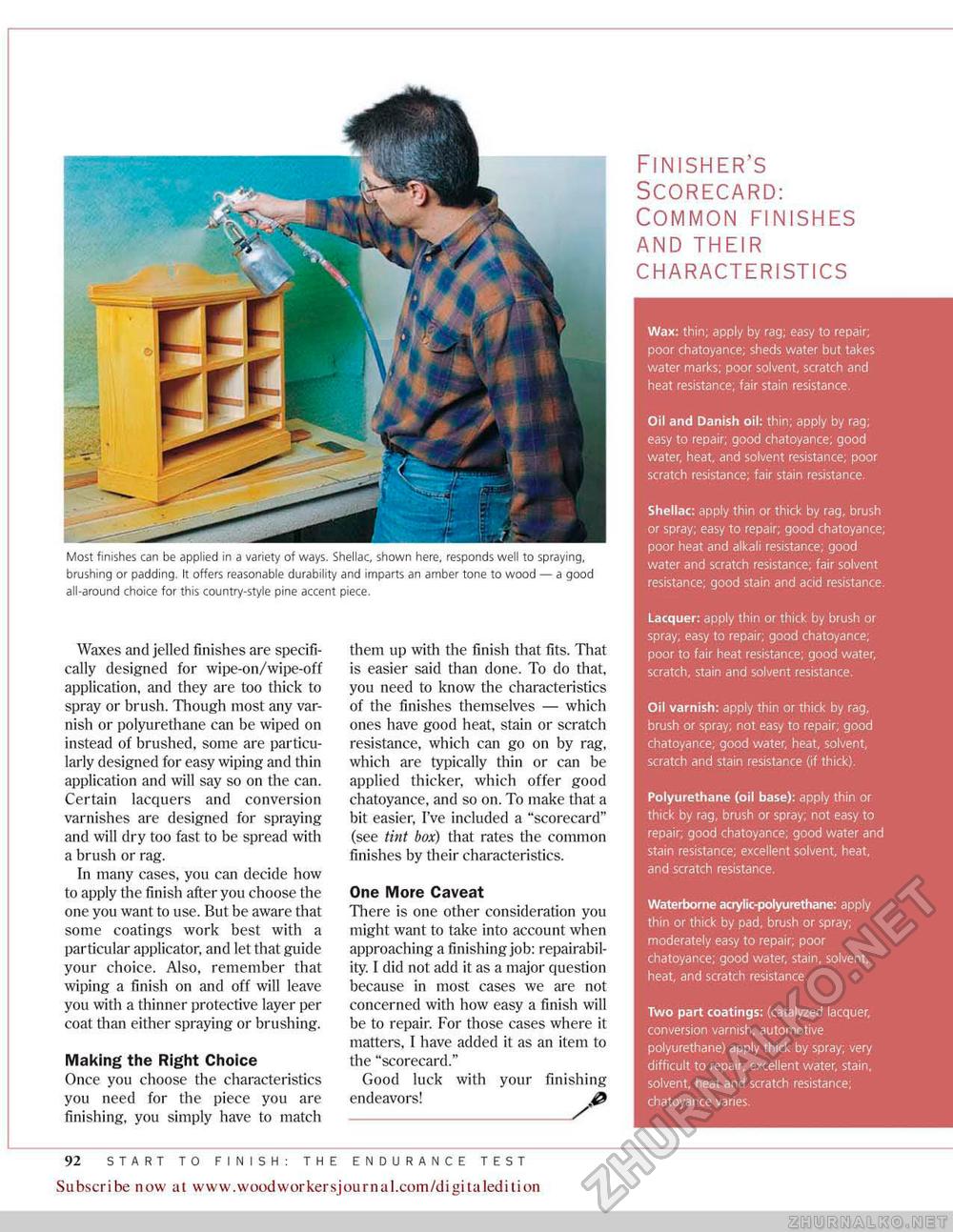Woodworker's Journal fall-2008, страница 92
Most finishes can be applied in a variety of ways. Shellac, shown here, responds well to spraying, brushing or padding. It offers reasonable durability and imparts an amber tone to wood — a good all-around choice for this country-style pine accent piece. Finisher's scorecard: common finishes and their characteristics Waxes and jelled finishes are specifically designed for wipe-on/wipe-off application, and they are too thick to spray or brush. Though most any varnish or polyurethane can be wiped on instead of brushed, some are particularly designed for easy wiping and thin application and will say so on the can. Certain lacquers and conversion varnishes are designed for spraying and will dry too fast to be spread with a brush or rag. In many cases, you can decide how to apply the finish after you choose the one you want to use. Rut be aware that some coatings work best with a particular applicator, and let that guide your choice. Also, remember that wiping a finish on and off will leave you with a thinner protective layer per coat than either spraying or brushing. Making the Right Choice Once you choose the characteristics you need for the piece yon are finishing, you simply have to match them up with the finish that fits. That is easier said than done. To do that, you need to know the characteristics of the finishes themselves — which ones have good heat, stain or scratch resistance, which can go on by rag, which are typically thin or can be applied thicker, which offer good chatoyance, and so on. To make that a bit easier, I've included a "scorecard" (see tint box) that rates the common finishes by their characteristics. One More Caveat There is one other consideration you might want to take into account when approaching a finishing job: repairabil-ity. I did not add it as a major question because in most cases we are not concerned with how easy a finish will be to repair. For those cases where it matters, I have added it as an item to the "scorecard." Good luck with your finishing endeavors! J& Wan: thin; apply by rag; easy to repair; poor chatoyance; sheds water but takes water marks; poor solvent, scratch and heat resistance; fair stain resistance. Oil and Danish oil: thin; apply by rag; easy to repair; good chatoyance; good water, heat, and solvent resistance; poor scratch resistance; fair stain resistance. Shellac: apply thin or thick by rag, brush or spray; easy to repair; good chatoyance; poor heat and alkali resistance; good water and scratch resistance; fair solvent resistance; good stain and acid resistance. Lacquer: apply thin or thick by brush or spray, easy to repair; good chatoyance, poor to fair heat resistance; good water, scratch, stain and solvent resistance. Oil varnish: apply thin or thick by rag, brush or spray; not easy to repair; good chatoyance; good water, heat, solvent, scratch and stain resistance (if thick). Polyurethane (oil base): apply thin or thick by rag, brush or spray; not easy to repair; good chatoyance; good water and stain resistance; excellent solvent, heat, and scratch resistance. Waterborne aerylic-polyurethane: apply thin or thick by pad, brush or spray; moderately easy to repair; poor chatoyance; good water, stain, solvent, heat, and scratch resistance. Two part coatings: (catalyzed lacquer, conversion varnish, automotive polyurethane) apply thick by spray; very difficult to repair; excellent water, stain, solvent, heat and scratch resistance; chatoyance varies. 92 START TO FINISH: THE ENDURANCE TEST Subscribe now at www.woodworkersjournal.com/digitaledilion |








